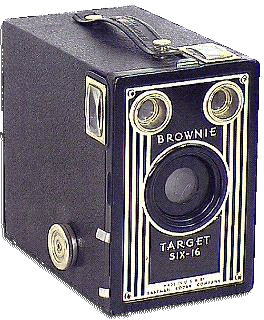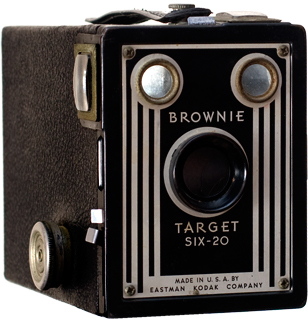
Approx. dates of manufacture: 1946 - 1951
Approx. original price: 616: $2.76 (1940), 620: $2.43 (1940)
Approx. street value: perhaps $5
This is a Brownie Target 616 made by Eastman Kodak somewhere between 1946 and 1951. This was the very first camera I ever bought. I paid 25¢ for it when I was eight years old from a now-defunct junk shop in Garbage Grove, California. I could probably get $5 for it at an antique store on consignment, so that's a hell of an appreciation, if you go by percentages.
So of course I wanted to try it out. 616 is the size of the film it takes, because Kodak numbered the film sizes that they sold (they called 35mm film 135). Kodak had quit making 616 cameras in the early 50s, though they continued making 616 film for 30 years after that. By the time I wanted it in the early 70s, you couldn't get it at the drug store; I had to call around and found out it at a (now defunct) camera store in Fullerton —for 75¢ a roll. This was the first, but not the last time, I bought a camera that cost less than the film it used.
Most people don't know anything about roll-film anymore, so I'll mention it here. Roll film is a length of film that's wound on a spool, just like 35mm. But unlike 35mm, roll films never settled on a single size. If the length of the spool is the maximum width of your image, you can still make the length of the image anything you want (within reason). That's why you can find a lot of cameras that all take the same size film (like 120) and but they make different size negatives. The bigger the negative, the fewer the photos you could take per roll. For 616 (and 620, and 120, for example), the big cameras took 8 photos. The middle-size cameras took 12, and the small cameras could squeeze 16 shots per roll.
This particular camera gave me eight shots. You can't tell the photo here but this camera makes pretty big negatives: 2 ½ x 4 ¼ inches (even when I had darkroom, it wasn't until about 10 years ago that I had an enlarger big enough to print them). I forgot what printing cost but it was a fortune for an 8-year old; I only did it once. Even with an 8-year old's eye, the photos were horrible. This camera has a single element lens and it was awful. There's a little red window in the back, which you used to read the numbers on the paper backing to tell where you were on the roll, was unprotected and the bright sun fogged the films, leaving a dark spot on each photo. I only ran one roll of film through it and it became bric-a-brac afterward. But it's still my first camera, and that makes it special. Now he sits on the top of one of my bookshelves.
A few other notes about the camera: two little lenses on the top are the waist-level finders for this camera. People of a certain age will remember these, but most of us are mercifully unacquainted with them. Light goes through the little lens, bounces on a mirror and an image forms on the rectangular glass on the side of the box (you can see both glass viewfinders on this photo—one on the left hand side and one on the top). When you look at the glass, you're supposed to look at the image that forms on the surface of the glass, as if you were looking at a reflection on a window-pane. Most people focus their eyes too far and try to look through the glass. The two different finders are for the two orientations of the camera. You look through the top one for portrait orientation, and through the side one if you're holding the camera sideways for landscapes.
On the side of the camera are the controls. The bent metal bar up in front is the shutter, which you flip down with your thumb. The shutter has one speed and you can trip it as often as you want, though it'll usually ruin your image to do it more than once. There's a pull-out tab above it that keeps the shutter open for as long as you hold it open (aka a Bulb setting). The pull-tab on top it is the aperture setting: you pull it out for bright days and leave it pushed in for anything else. The knob on the side is used to wind the spool to advance your film. You can't see it on this photo, but in the back there's a little red window where you could see the paper backing on the film roll, and the manufacturer would print numbers on it. So you wound film until the number of your next area of blank film was in position to be exposed.
 My second camera was a Brownie Target 620. It looks like the identical little brother of this guy, the only difference is that he
takes 620 film. 620 was a much more popular format, and except for a tiny difference in the spool (curse you, Kodak), it's the same size as 120 film. Kodak discontinued 620 a decade or
so ago, but you can still buy 120 today (because parodoxically, 120 is used in many extremely expensive professional's cameras). So if you're willing to wrestle with it a bit, or if you
have a darkroom and can respool it, you can still run film through it.
My second camera was a Brownie Target 620. It looks like the identical little brother of this guy, the only difference is that he
takes 620 film. 620 was a much more popular format, and except for a tiny difference in the spool (curse you, Kodak), it's the same size as 120 film. Kodak discontinued 620 a decade or
so ago, but you can still buy 120 today (because parodoxically, 120 is used in many extremely expensive professional's cameras). So if you're willing to wrestle with it a bit, or if you
have a darkroom and can respool it, you can still run film through it.
Brownie was a Kodak-created line of extremely inexpensive cameras. Target, however, came from (I believe) Blair Camera Corp. When Kodak bought out Blair, they also acquired a lot of their camera lines, and Target was one of them. Kodak liked to make a myriad of different cameras that were essentially the same but with minor styling variations, so later cameras that are nearly identical carry the Brownie name, or Target, or Hawk-Eye, or Premo, etc., or some combination of them.
If you noticed the resemblance to the names Target, Hawk-Eye and Bulls Eye, among others, that is not a coincidence. In the late 19th century when cameras were still a cottage industry, when someone made a popular camera the competition would make knock-offs and give them similar names, hoping that consumers might confuse the popular camera with a maker's own offering. The mergers-upon-mergers that consolidated the photo industry in the early 20th century brought a lot of these names under one parent corporation— and most of them became Kodaks.
Camera manual: Orphan Cameras.com


